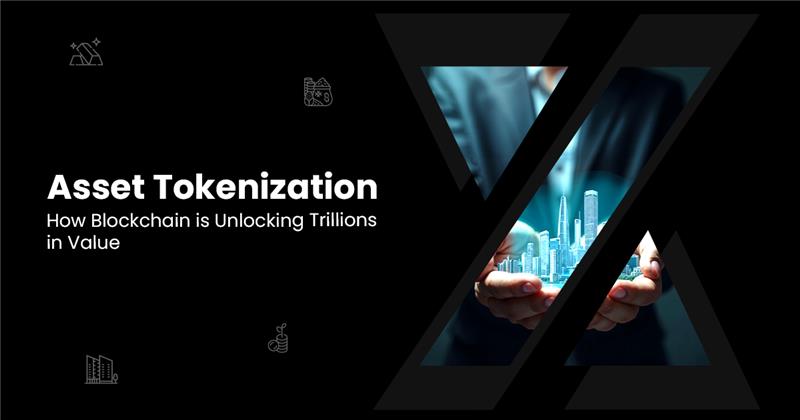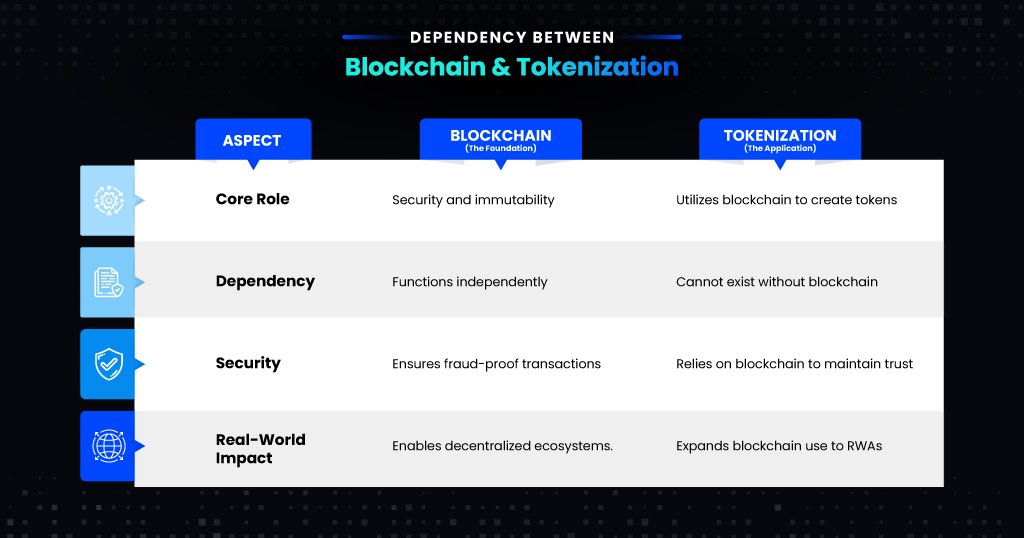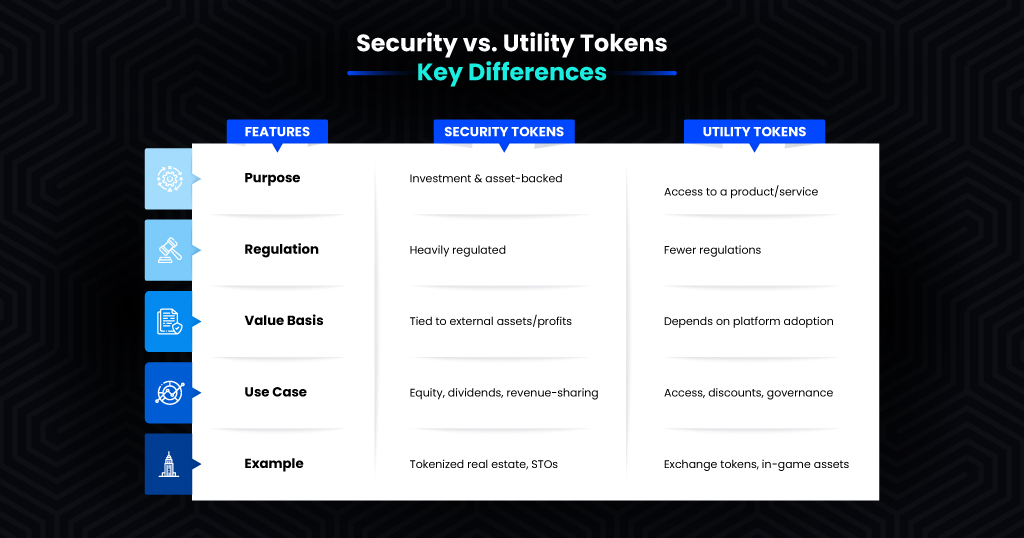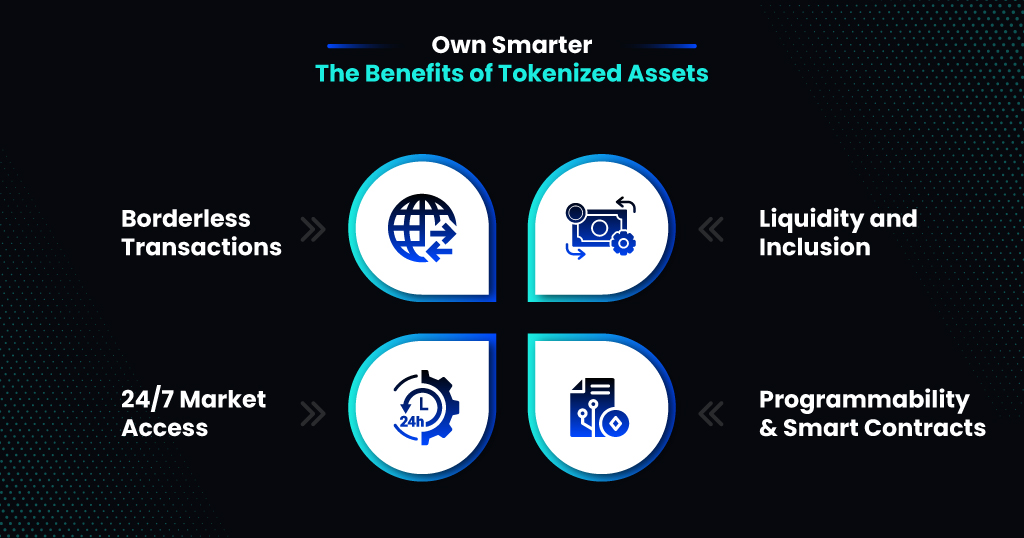
“Tokenization allows us to bring liquidity to previously illiquid assets.”
— Andreas M. Antonopoulos
The above quote is quite right in the current context where everything from education to finance is running on the digital interface. The quote has captured perfectly the essence of the evolving trend from traditional to digital trading and investment. This has changed the face of finance where the traditional approach limits the participation of a range of investors. With the introduction of asset tokenization in finance, everyone can easily access and trade previously inaccessible assets.
In this blog post, we will understand how asset tokenization is shaping modern finance, the role of blockchain technology in tokenized assets, the benefits of tokenization, and digital asset ownership
Key Takeaways:
Asset tokenization is revolutionizing financial markets by increasing liquidity.
Blockchain ensures secure and transparent tokenized transactions.
Real estate, stocks, and art are among the assets being tokenized.
Regulatory frameworks are evolving to accommodate tokenized securities.
Institutional adoption of tokenization is accelerating.
The Future of Finance: How Asset Tokenization is Reshaping Ownership
Tokenization entered the domain of finance and has been creating buzz around not just digital asset ownership but also in the region of physical asset ownership. This revolution in ownership isn’t just changing how we buy and sell assets—it’s fundamentally transforming our relationship with wealth.
Furthermore, tokenization in finance allows investors and traders to own a part of high-value assets with the help of fractional ownership. This method allows investors of all ranges, let it be institutional as well as retail to buy, sell, and invest in the premium tokenized asses that were previously out of reach of the normal investors. The framework backed security enhances the investment opportunity and makes the financial domain inclusive for all.
What Exactly is Tokenization?
Now, the question arises what exactly tokenization is, there are several blogs in which we have previously seen the meaning of tokenization. Let us once recall it, to answer in exact terms, tokenization is a process that transforms traditional assets into digital tokens on blockchain platforms. Think of it like this: instead of a paper deed for a building, ownership gets represented by digital tokens that can be bought, sold, or traded online without intermediaries slowing things down. This is how tokenization works, reimagining the face of both physical as well as digital asset ownership.
The concept is not actually new. People have been dividing ownership of assets for centuries—think timeshares or stock markets. However, what is revolutionary is the technology behind it, that is blockchain technology. Blockchain technology which is one of the most innovative technologies in recent times, provides unprecedented security, transparency, and efficiency that traditional systems simply can’t match.
Blockchain Tokenization: Breaking Free from Traditional Limitations
Traditional asset ownership comes with significant baggage and restricts mass from owning the premium assets. For example, real estate transactions drag on for months and the paperwork surrounding it makes it a cumbersome process. And when it comes to art collectors, they need deep pockets to participate. Stocks require brokers who charge hefty fees.
Tokenization eliminates these barriers and allows investors even with limited capital to participate in these assets. By splitting assets into affordable digital tokens, markets once restricted to the wealthy become accessible to everyday investors. A $10 million painting can be divided into thousands of tokens, allowing art enthusiasts to own a slice for just a few hundred dollars. This step has increased the financial inclusion of the investors and makes this domain more accessible to everyone regardless of their wealth.
Dependency Between Blockchain & Tokenization

Behind tokenization stands blockchain technology—a distributed digital ledger that records all transactions across a network of computers. It acts as a foundational part of tokenization allowing more people to engage in trading and investment process. Unlike centralized databases controlled by single institutions, blockchain records cannot be altered once created, making fraud virtually impossible. This framework enhances the security and transparency of the tokenized assets.
Smart contracts, one of the key elements of blockchain technology, are self-executing programs stored on blockchains. They automate the rules of ownership and transactions for these tokenized assets. When someone buys a tokenized asset, smart contracts handle everything from verifying identity to transferring ownership, eliminating paperwork and reducing costs dramatically.
Major Asset Categories Leveraging Blockchain Tokenization

Tokenization is not limited to just a few assets; it has been embracing multiple assets around the world and giving all investors and traders to grow more in their financial journey. Here are a few major assets which are becoming more and more popular among the masses:
Real Estate Leads the Way
Real estate, one of the most significant areas for investment, represents the perfect testing ground for tokenization. By leveraging tokenization, properties worth millions can now be divided among hundreds of investors, each owning their proportional share. Manhattan luxury apartments, commercial buildings in Tokyo, and vacation rentals in Barcelona have all been successfully tokenized, creating new investment opportunities previously unavailable to most people.
There are several trading platforms for tokenized real-world asses which have already tokenized millions in property assets, allowing investors to start building real estate portfolios with as little as $50.
Stocks and Securities Go Digital
The benefits of tokenization are not limited to premium real estate only, as they have entered the domain of stocks and securities as well. Traditional stock markets operate on outdated technology with settlement times taking days. Tokenized stocks enable instant trading and settlement, reducing costs and eliminating counterparty risks.
Overall, tokenized securities and stocks make the process more efficient saving both time and money. Furthermore, major financial institutions are not sitting on the sidelines either. Various platforms and marketplaces have opened their door for blockchain-powered tokenized assets, including the initiatives exploring tokenized securities. These companies are recognizing that this technology could reshape their industry.
Art Without the Gallery
The art world has embraced tokenization enthusiastically, enabling collectors and visitors to engage in investment opportunities. Blue-chip artwork worth millions can now be owned collectively. This framework democratizes access to fine art investing.
There are a few major marketplaces and trading platforms for tokenized real-world assets, leading this space, tokenizing works by artists like Banksy and Picasso. Investors receive fractional ownership and potential appreciation while the physical artwork remains professionally stored and insured.
Commodities Get Digital Packaging
Tokenization has also embraced the domain of commodities like gold, silver, oil, and agricultural products. There are several trading platforms for tokenized real-world asses that offer gold-backed tokens where each token represents ownership of physical gold stored in secure vaults. These tokens can be traded 24/7, unlike traditional commodity markets with limited hours.
Security vs. Utility: Understanding Token Types

When we talk about tokenization and how it converts real-world assets into digital tokens. Let us be very specific that, not all tokens serve the same purpose. Security tokens represent ownership in assets and fall under securities regulations. They entitle holders to ownership rights, dividends, or profit-sharing.
On the other hand, utility tokens, function more like digital keys granting access to specific products or services within blockchain ecosystems. They are not primarily investments but tools for participating in digital platforms.
This distinction matters enormously for regulatory compliance. Security tokens must adhere to financial regulations like any traditional security, while utility tokens operate under different frameworks.
Own Smarter: The Benefits of Tokenized Assets

Asset tokenization is gaining momentum and getting hold of the market. It provides the investors with multiple benefits. A few of the most important ones are as follows:
Liquidity Transforms Illiquid Markets
Perhaps tokenization’s greatest achievement is injecting liquidity into traditionally illiquid markets. Real estate, fine art, commodities, and private equity investments once locked investors’ capital for years. Tokenization creates secondary markets where these assets can trade as easily as stocks, allowing more fluidity in the market.
Further, this liquidity transforms investment strategies. This facilitates investors diversification options across asset classes previously unavailable to them. This aids them in adjusting portfolios without waiting months to exit positions.
Transparency Creates Trust
Blockchain’s immutable record-keeping creates unprecedented transparency. Every ownership transfer gets permanently recorded, creating perfect provenance records. Art collectors can trace a piece’s ownership history back to its creation. Property investors see every previous transaction on a building.
This transparency reduces fraud risk dramatically—a persistent problem in traditional asset markets.
Challenges on the Road Ahead
Despite its promise, tokenization faces significant hurdles. Regulatory frameworks remain incomplete in many jurisdictions. Questions about cross-border transactions, taxation, and investor protection need clearer answers.
Technical challenges persist too. Different blockchain platforms often cannot communicate effectively, creating potential silos. And while blockchain offers security advantages, custody solutions for digital assets still need refinement.
Cultural resistance represents another obstacle. Many investors and institutions remain comfortable with familiar systems despite their inefficiencies. Education and demonstration projects will be essential to drive adoption.
As tokenization in real-world assets is gaining momentum in the market; several platforms allow their trading and investment. One such platform is STOEX.
STOEX is backed by KALP Distributed Ledger Technology (DLT) and strictly adhered to regulatory compliance, ensuring transparency and liquidity. With its structured approach, stringent security, and commitment to compliance, the platform offers an appealing option for diversified and efficient investing. Its regulation, security measures, focus on usability and customer-centric approach make it stand out as an accessible way of trading tokenized real-world assets.
Additionally, STOEX’s vision is to build a ground with reduced entry barriers and encourage a safe ecosystem for every individual interested in investing in the market. It pulls the strings of financial democratization by bridging the gap between investors and high-worth tokenized RWAs.
The Bottom Line
Asset tokenization represents nothing less than the next evolution of ownership. By removing intermediaries, reducing minimum investments, and creating liquidity in previously illiquid markets, it is democratizing access to investment opportunities once reserved for the privileged few.
For investors, businesses, and consumers alike, understanding this transformation is not optional—it is essential preparation for the financial landscape taking shape. Those who grasp asset tokenization’s potential earliest will find themselves positioned to benefit from one of finance’s most significant innovations since the creation of stock exchanges.
The tokenized future is not coming—it is already here. The only question remaining is how quickly traditional markets will transform in response. As these concepts are still evolving, various platforms are adding to the layer of opportunities and options within these domains. One such option is STOEX, which allows investors to access the marketplace and trade effortlessly.
FAQs
What is tokenization in finance?
Tokenization is the process of converting real-world assets into digital tokens that can be traded on a blockchain platform.
How does blockchain enable tokenization?
Blockchain provides a decentralized ledger that ensures secure, transparent, and immutable transactions for tokenized assets.
What are the benefits of tokenized assets?
Tokenized assets improve liquidity, enable fractional ownership, and enhance transparency in financial transactions.
Is tokenization legal?
Tokenization is legal, but its regulatory framework varies across different countries and asset classes.
How can investors buy tokenized assets?
Investors can buy tokenized assets through digital asset exchanges or platforms offering security tokens.

